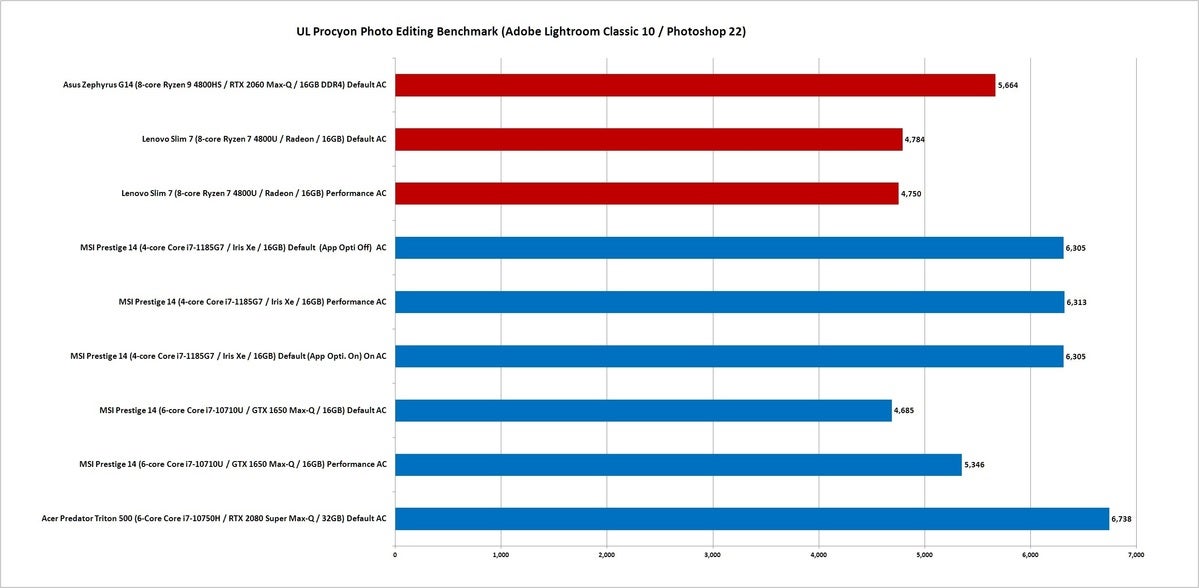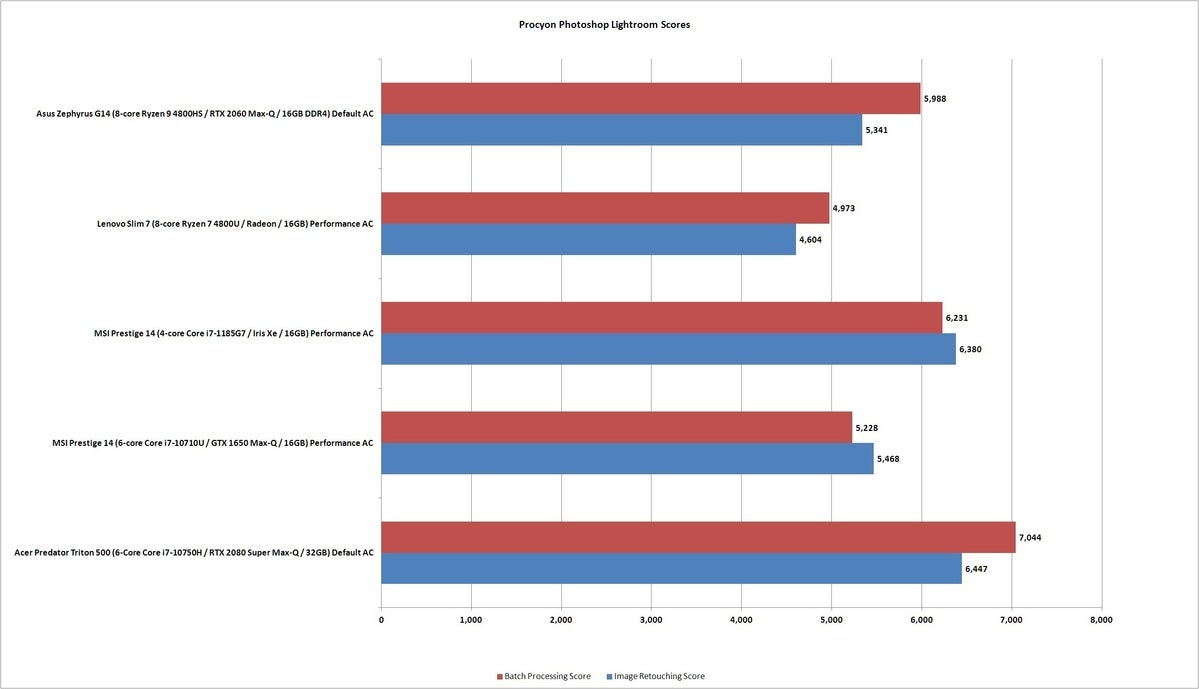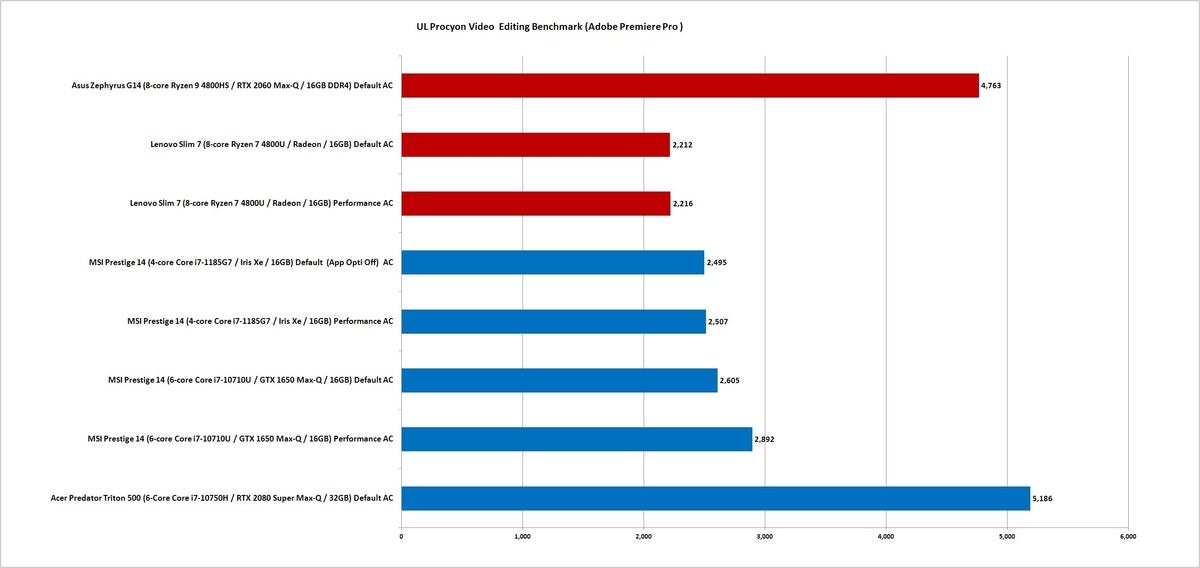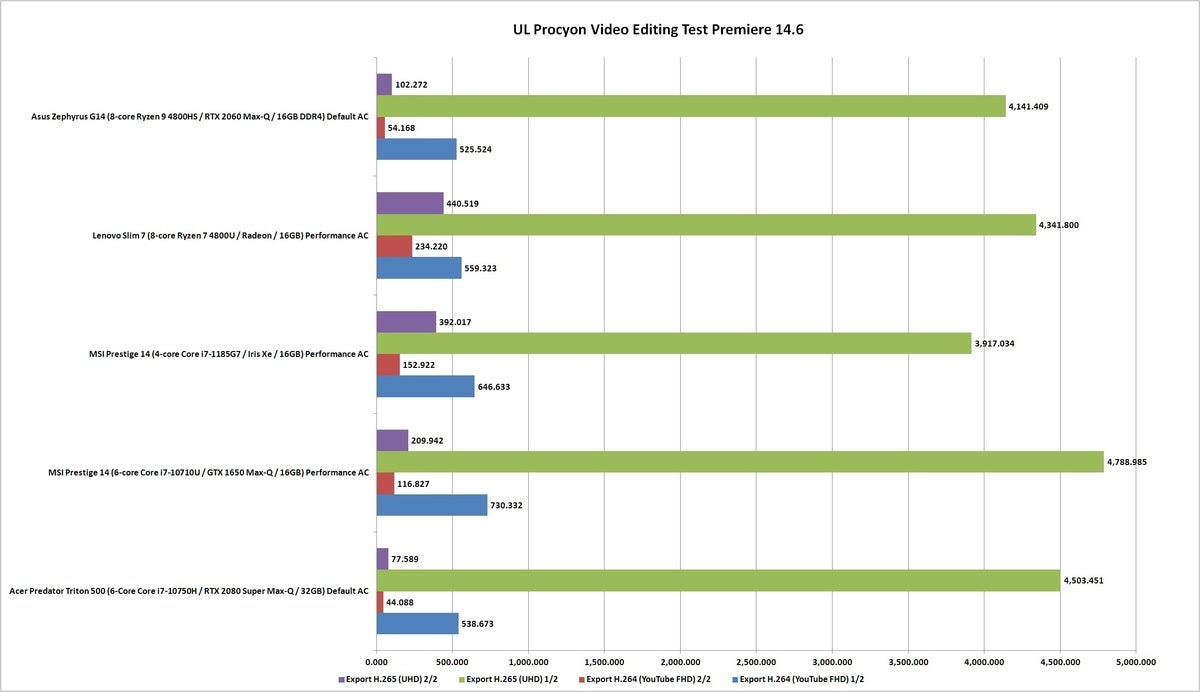[ad_1]
Just as gamers want their laptops to run Crysis, creators want their laptops to run Adobe Creative Cloud without a hitch. The choice was easy when Intel dominated mobile CPUs, but AMD’s Ryzen is a formidable up-and-comer now. Does it matter which one your laptop runs? We decided to run Photoshop, Lightroom, and Premiere through two benchmark suites to see which mobile CPU performs best.
What follows is a raft of charts, and they’re well worth perusing if you care about the nuances of application performance. But if you want to jump to the test that interests you most, or skip directly to the conclusion, use the handy hotlinks below.
The benchmarks: Procyon and Pugetbench
The first suite, and the “new kid” on the benchmark block, is UL’s Procyon (pronounced “PRO-see-on.”). Made by the same company that publishes the popular 3DMark, Procyon has two modules. The first is a Photo Editing module that runs Photoshop and Lightroom Classic through a set of scripts. The second module measures Premiere Pro performance. The benchmark doesn’t have a free version and is priced mostly for professionals.
The second benchmark is Puget System’s Puget Bench. Puget Systems is a Washington-based workstation builder that developed its own benchmark suite to help support its customers. The company offers a paid version and a free public version of Puget Bench; we used the latter.
It’s important to note that Procyon and Puget Bench are not synthetic tests. To run them, you need to have the Adobe applications installed. Both benchmark suites then run the applications through a scripted set of tests.
Our test laptops
The laptops we used for our tests were chosen to represent a variety of CPUs, and both discrete and integrated graphics:
- MSI’s Prestige 14 Evo is equipped with a 4-core, 11th-gen Core i7-1185G7 with Iris Xe graphics, 16GB of LPDDR4X/4267 memory, a 512GB PCIe Gen 4 SSD, and a 14-inch FHD screen. It weighs 2.7 pounds.
- MSI’s older Prestige 14 is equipped with a 6-core, 10th-gen Core i7-10710U, GeForce GTX 1650 Max-Q graphics, 16GB of LPDDR3/2133 memory, a 1TB PCIe 3.0 SSD, and a 14-inch 4K screen. It weighs 2.8 pounds.
- Lenovo’s Yoga Slim 7 has an 8-core Ryzen 4800U with Radeon graphics, 16GB of LPDDR4X/4267 memory, a 512GB PCIe 3.0 SSD, a 14-inch FHD, and lap weight of 3.1 pounds.
- The Asus ROG Zephyrus G14 includes an 8-core Ryzen 9 4900HS (sometimes mistyped as ‘4800HS’ in the charts that follow), GeForce RTX 2060 Max-Q graphics, 16GB of DDR4/3200 memory, a 1TB PCIe 3.0 SSD, a 14-inch FHD screen, and a weight of 3.6 pounds.
- The Acer Predator Triton 500 with a 6-core 10th-gen Core i7-10750H CPU, GeForce RTX 2080 Super Max-Q graphics, 32GB of DDR4/3200 memory, a 1TB PCIe 3.0 SSD, and a 15.6-inch 300Hz FHD screen. It weighs 4.6 pounds.
This selection gives us a nice mix of AMD and Intel CPUs, as well as three performance levels of Nvidia’s GeForce cards. It does make it a little hard to figure what exactly is driving any performance changes, but we can make some educated guesses. Normally we wouldn’t pit a 4.6-pound laptop with Nvidia’s most powerful GPU against a 2.7-pound laptop with integrated graphics, but in this case we want to see just what you get in exchange for the extra weight.
It’s also important to note that there is no real ‘right answer’ when you’re trying to determine performance based on applications as vast as Adobe’s suite. What you do in Photoshop, Lightroom or Premiere may not be what someone else does in those apps—and may yield different results. Benchmarks help us compare consistently, but your mileage will vary.
UL Procyon Photo Editing
The Procyon image editing module rolls up both Photoshop and Lightroom results into the same overall score. The entire test takes about 20 minutes to run.
The laptops with AMD CPUs are shown as a grouping of red bars, above a grouping of Intel laptops in blue bars. Some laptops have multiple bars to show performance at different CPU settings. In all cases, a longer bar indicates higher performance.
Looking at the results, we can see the MSI Prestige 14 Evo and its Core i7-1185G7 leads among the smaller and lighter laptops, beating both the prior-generation MSI Prestige 14 with 10th-gen Core i7-10710U and GeForce GTX 1650 Max-Q, and the thin-and-light Lenovo Yoga Slim 7 laptop with Ryzen 7 4800U.
The other trend we see from Procyon’s Photo Editing test is the importance of the GPU. Both the Asus ROG Zephyrus G14 and the Acer Predator Triton 500 likely get a very nice boost due to their GeForce graphics.
 IDG
IDGThe chart below is broken into two categories: batch processing (red bar), which is performed all in Lightroom, and image retouching (blue bar), which is performed all in Photoshop.
The larger Acer Predator Triton 500 gaming laptop with its fast GPU leads here. The 11th-gen Tiger Lake MSI Prestige 14 Evo laptop has a decent advantage against both the older MSI Prestige 14 and the Lenovo Yoga Slim 7, and it can even outperform the Ryzen 9 4900HS and GeForce RTX 2060 Max-Q in the Asus ROG Zephyrus G14.
 IDG
IDGOne thing we don’t know is whether the PCIe 4.0 SSD in the MSI Prestige 14 Evo bears some responsibility for the performance. Our gut says drive speed has rarely been a bottleneck, but storage could very much be helping the Tiger Lake laptop. IDG
Procyon Premiere Performance
We’ll finish off Procyon results with a look at its video test. Procyon tasks Premiere with exporting four files: Two are H.264 using the YouTube preset with Maximum Render quality, and two use H.265 and export to a UHD 4K resolution file, again with maximum render quality. The source file is a 4K video with lumetric color and noise correction applied to the clips. Other clips use the filter twirl, Gaussian blur, cross dissolve and motion applied, as well as crop, color balance, fast blur, sharpen.
If you look only at this chart (which includes running smaller laptops using their available default and performance cooling settings), you know the laptops with discrete graphics win, with the Acer Predator Triton 500’s GeForce RTX 2080 Super in first and the Asus ROG Zephyrus G14’s GeForce RTX 2060 in second place. Surprisingly, the GeForce GTX 1650 doesn’t hand the Prestige MSI 14 the win you’d expect. The MSI Prestige 14 Evo’s 11th-gen Tiger Lake with only 4 cores surprisingly bests the Lenovo Yoga Slim 7 with an 8-core Ryzen 7 4800U inside of it.
 IDG
IDGProcyon’s script for Adobe Premiere actually hands the 8-core Ryzen 7 4800U the L.
There’s a bit more to Procyon’s story. As we said above, the clips have various effects filters applied and also are broken up in two sections. One is made to be accelerated by the graphics cores—discrete or integrated, we suspect—as well as what looks to be conventional CPU encoding.
For the GPU encodes, those with the fastest lead the way. The laptops with GeForce RTX 2080 Super, GeForce RTX 2060, and GeForce GTX 1650 slide into a neat 1, 2, 3 sequence. You can see the results in the purple and red bars below (shorter bars are better, as the scores indicate how long it took to encode the videos).
 IDG
IDGIn the two CPU-heavy exports in green and blue, the two 8-core Ryzen chips actually do quite well. Looking at the blue bar for the H.264 export, the Asus ROG Zephyrus 14’s Ryzen 9 4900HS crosses the finish line first, closely followed by Acer Predator Triton 500 with the 6-core Core i7-10750H and the Lenovo Yoga Slim 7’s 8-core Ryzen 7 4800U. The MSI Prestige 14 Evo’s 4-core, 11th-gen Tiger Lake, and its predecessor Prestige 14’s 6-core, 10th-gen Comet Lake U, take up the rear.
That 1080p video is a fairly short run, though. Exporting to the much more strenuous H.265 codec at 4K (green bar) takes our encode from about 10 to about 72 minutes. The surprise winner for that H.265 encode is the MSI Prestige 14 Evo’s 4-core 11th Gen Core i7-1185G7 which etches a solid win over both laptops with 8-core Ryzen 4000 CPUs. Both of the older 14nm 10th-gen CPUs come in last, but not by much, which makes us think the CPU-based visual effects Premiere applies to the videos are an important factor here. It’s also why, frankly, we think the 11th-gen Tiger Lake CPU does as well as it does.
Procyon Conclusion
Looking at Procyon in totality, it’s clear that having a fast GPU supported by Adobe products helps—sometimes a lot. We’d also say that while AMD’s Ryzen 4000 can outperform Intel’s 11th-gen Tiger Lake, it doesn’t always do so where you’d expect it to. Photoshop, which still largely relies on lighter thread thread counts and burst clocks, continues to favors Tiger Lake.
If we had to declare a winner among the laptops without a graphics chip, we’d give it to Intel’s 11th-gen Tiger Lake. AMD’s Ryzen 4000 performs competently, but its strength continues to be in multi-core performance.
If we were buying a laptop based solely on Procyon, it would largely depend on how the work is split. If your work is mostly within Adobe apps, the 11th-gen Tiger Lake looks to be the overall winner. If, however, you also perform multi-threaded work such as 3D modelling, then the higher-core-count Ryzen 4000 can do both capably.
Keep reading to see how Pugetbench puts the laptops through their paces.
[ad_2]
Source link